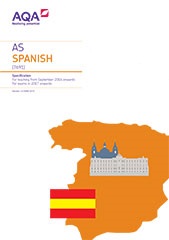3.3 Grammar
AS students will be expected to have studied the grammatical system and structures of the language during their course. Knowledge of the grammar and structures specified for GCSE is assumed.
In the exam students will be required to use, actively and accurately, grammar and structures appropriate to the tasks set, drawn from the following list. The mention of an item in this list implies knowledge of both its forms and its functions at an appropriate level of accuracy and complexity.
The examples in italics in parentheses are indicative; they serve to illustrate the part of speech or structure that the student must know and do not represent an exhaustive specification of the required grammatical knowledge. For items marked (R), receptive knowledge only is required.
Nouns
Gender
Singular and plural forms
Plural of male/female pairs (eg los Reyes)
Affective suffixes (R)
Articles
Definite and indefinite
El with feminine nouns beginning with stressed a (el agua)
Lo + adjective
Adjectives
Agreement
Position
Apocopation (eg gran, buen, mal, primer)
Comparative and superlative (eg más fuerte; mejor, peor, mayor, menor)
Use of adjectives as nouns (eg una triste, la roja, las norteamericanas)
Demonstrative (eg este, ese, aquel)
Indefinite (eg alguno, cualquiera, otro)
Possessive (weak and strong forms) (eg mi / mío)
Interrogative and exclamatory (eg ¿cuánto? / ¡cuánto!, etc, including use of ¿qué? / ¡qué!)
Relative (cuyo) (R)
Numerals
Cardinal (eg uno, dos)
Ordinal 1–10 (eg primero, segundo)
Agreement (eg cuatrocientas chicas)
Expression of time and date
Adverbs
Formation of adverbs in -mente
Comparative and superlative (eg más despacio)
Use of adjectives as adverbs (eg rápido, claro)
Adjectives as equivalents of English adverbs (eg Salió contenta)
Interrogative (eg ¿cómo?, ¿cuándo?, ¿dónde?)
Quantifiers/intensifiers
(eg muy, bastante, poco, mucho)
Pronouns
Subject
Object: direct and indirect; use of se for le(s); ‘redundant’ use of indirect object (eg Dale un beso a tu papá)
Reflexive
Unstressed/stressed forms (eg me/mí)
Position and order
Relative (que, quien, el que, el cual)
Demonstrative (este, ese, aquel; esto, eso, aquello)
Indefinite (eg algo, alguien)
Possessive (eg el mío, la mía). Expression of possession by the use of the indirect object pronoun (Le rompió el brazo) must also be included.
Interrogative
Verbs
Regular conjugations of -ar, -er and -ir verbs, including radical-changing (eg recordar/recuerdo, pedir/pido) and orthographic-changing (eg abrazar/ abracé) verbs in all tenses and moods, finite and non-finite forms
Regular and irregular verbs, in all tenses and moods, finite and non-finite forms
Agreement of verb and subject
Use of hay que in all tenses
Use of tenses:
- present
- preterite
- imperfect
- future
- conditional
- perfect
- future perfect
- conditional perfect
- pluperfect.
Use of the infinitive, the gerund and the past participle
Verbal paraphrases and their uses. These include but are not limited to the following:
- ir a + infinitive
- estar + gerund
- acabar de + infinitive
- estar para + infinitive
- llevar + gerund
- ir + gerund (R)
- venir + gerund (R).
Use of the subjunctive
Commands
Conditional sentences
After conjunctions of time
After para que, sin que
In relative clauses (R)
After other subordinating conjunctions (R)
With verbs and verbal expressions of wishing, commanding, influencing, emotional reaction, doubt, denial, possibility, probability (R)
Sequence of tense in indirect speech and other subordinate clauses
Voice
Use of the reflexive as a passive (eg El puente se construyó para unir a las comunidades)
Use of the reflexive to express an impersonal subject (eg ¿Cómo se llega a la estación?)
Use of ser + past participle
Use of estar + past participle
‘Nuance’ reflexive verbs (eg caerse, pararse)
Modes of address (tú, usted; vos (R))
Constructions with verbs
Verbs followed directly by an infinitive (eg querer, poder)
Verbs followed by a preposition plus an infinitive or noun phrase (eg insistir en, negarse a)
Verbs followed by a gerund (eg seguir)
Verbs of perception (eg Vi asfaltar la calle)
Uses of ser and estar
Prepositions
All prepositions, both simple (eg bajo) and complex (eg encima de)
‘Personal’ a
Discrimination of por and para
Conjunctions
Coordinating conjunctions (eg y, o, pero)
Subordinating conjunctions. These include but are not limited to the following:
- cause (porque)
- purpose (para que)
- proviso (con tal que)
- supposition (a no ser que)
- time (cuando)
- concession (aunque).
Use of que to introduce a clause (eg ¡Cuidado, que se va a quemar la tortilla!) (R)
Negation
Questions
Commands
Word order
Subject following verb (Ha llegado el profesor; Me gustan las patatas)
Focalisation (Tú ¿qué opinas?; A Cristiano lo odian) (R)
Other constructions
Time expressions with hace/hacía and desde hace/hacía
Cleft sentences (Fue en Madrid donde nos conocimos)
Comparative constructions. These include but are not limited to the following:
- tan... como..., etc
- más... que..., etc.
Tiene más dinero de lo que creía (R)
Indirect speech
Discourse markers
(eg Es que..., Por ejemplo, Ahora bien...)
Fillers
(eg pues, bueno)
